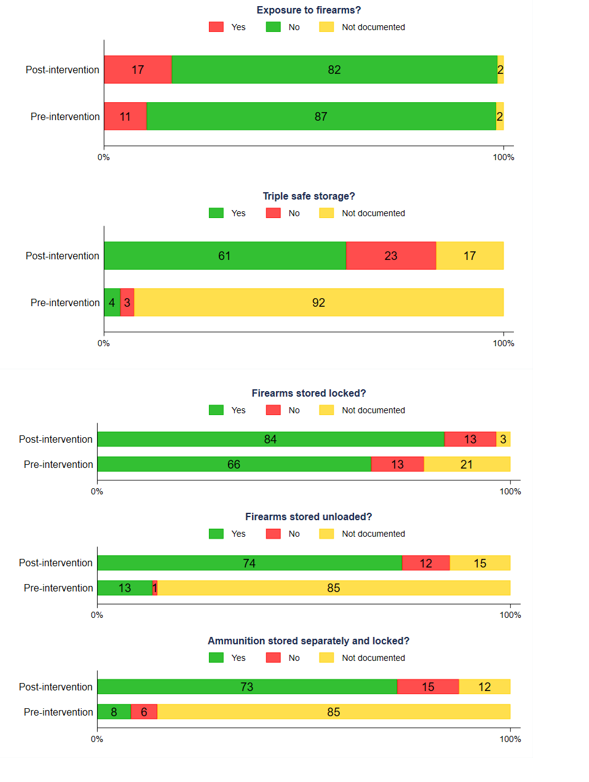Emergency Medicine: All Areas
Category: Abstract Submission
4: Emergency Medicine I
39 - Identification of Firearm Ownership and Storage Practices in Families of Children with Emergent Mental Health Complaints
Friday, April 22, 2022
6:15 PM - 8:45 PM US MT
Poster Number: 39
Publication Number: 39.103
Publication Number: 39.103
Neil G. Uspal, University of Washington School of Medicine, Seattle, WA, United States; Julia Nichols, Seattle Children's, Lake Forest Park, WA, United States; Miranda Bradford, Seattle Children's, Seattle, WA, United States; Bonnie Strelitz, Seattle Children's, Seattle, WA, United States
.jpg)
Neil G. Uspal, MD (he/him/his)
Professor
University of Washington School of Medicine
Seattle, Washington, United States
Presenting Author(s)
Background: In the United States, suicide was the second leading cause of mortality in children ages 11-17 in 2019; firearms were the cause of 40% of these deaths. Firearms in the home are associated with an increased risk of youth suicide; this risk can be reduced through safe firearm storage. Lethal means counseling can improve firearm storage practices, but only if firearm ownership is first identified.
Objective: Our objective was to describe patterns of firearm ownership in families of pediatric patients with mental health complaints in an emergency department (ED) and determine if training & changes to the electronic health record (EHR) improved identification of firearm ownership and storage practices.
Design/Methods: Retrospective, single center study of pediatric hospital ED visits for mental health complaints in 0–17-year-olds from 1/20/15 - 11/13/17. As part of a prospective study of a safe firearms storage intervention, the ED changed its EHR mental health evaluation template from asking if patients had “access to weapons” to asking specific questions about family ownership and storage of firearms. Mental health staff study and template training occurred from 10/26/15 to 2/10/16, EHR changes occurred on 1/20/16, & the study began on 2/12/16. Triple-safe storage was defined as storing firearms unloaded, locked, & with ammunition stored and locked separately. We performed chi-squared analyses to (1) examine if patient demographics differed between firearm and non-firearm owning families across the study period and (2) determine if the frequency of identification of firearm ownership changed before and after changes to the EHR screening template.
Results: 5,590 eligible patient visits were analyzed. Patients with exposure to firearms differed significantly from families without exposure to firearms by race, ethnicity, insurance status, and population density (Table). Identification of firearm ownership increased post- versus pre- intervention (17%, 95% CI: 16-18% vs. 11%, 95% CI: 9-12%, p< 0.01). In identified firearm owners, unsafe storage practices were documented more frequently in the post-intervention period (Figure).Conclusion(s): An intervention involving education & EHR changes resulted in increased identification of family firearm ownership & unsafe storage practices. Under-identification of firearm ownership & unsafe storage practices may place children at increased risk of suicide. Providers of mental health care to children in emergent settings should be specifically trained in and provided tools for identification of exposure to firearms and unsafe storage practices.
Patient characteristics by firearms exposure status.png) *excludes patients whose firearm exposure was unknown
*excludes patients whose firearm exposure was unknown
Documentation of firearms exposure, triple-safe storage, and triple-storage components pre- and post- intervention
Objective: Our objective was to describe patterns of firearm ownership in families of pediatric patients with mental health complaints in an emergency department (ED) and determine if training & changes to the electronic health record (EHR) improved identification of firearm ownership and storage practices.
Design/Methods: Retrospective, single center study of pediatric hospital ED visits for mental health complaints in 0–17-year-olds from 1/20/15 - 11/13/17. As part of a prospective study of a safe firearms storage intervention, the ED changed its EHR mental health evaluation template from asking if patients had “access to weapons” to asking specific questions about family ownership and storage of firearms. Mental health staff study and template training occurred from 10/26/15 to 2/10/16, EHR changes occurred on 1/20/16, & the study began on 2/12/16. Triple-safe storage was defined as storing firearms unloaded, locked, & with ammunition stored and locked separately. We performed chi-squared analyses to (1) examine if patient demographics differed between firearm and non-firearm owning families across the study period and (2) determine if the frequency of identification of firearm ownership changed before and after changes to the EHR screening template.
Results: 5,590 eligible patient visits were analyzed. Patients with exposure to firearms differed significantly from families without exposure to firearms by race, ethnicity, insurance status, and population density (Table). Identification of firearm ownership increased post- versus pre- intervention (17%, 95% CI: 16-18% vs. 11%, 95% CI: 9-12%, p< 0.01). In identified firearm owners, unsafe storage practices were documented more frequently in the post-intervention period (Figure).Conclusion(s): An intervention involving education & EHR changes resulted in increased identification of family firearm ownership & unsafe storage practices. Under-identification of firearm ownership & unsafe storage practices may place children at increased risk of suicide. Providers of mental health care to children in emergent settings should be specifically trained in and provided tools for identification of exposure to firearms and unsafe storage practices.
Patient characteristics by firearms exposure status
.png) *excludes patients whose firearm exposure was unknown
*excludes patients whose firearm exposure was unknownDocumentation of firearms exposure, triple-safe storage, and triple-storage components pre- and post- intervention

